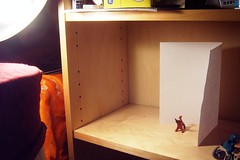Photographing Small Sculptures
Polymer clay critters (not to mention jewellery, etc.) are not the easiest thing in the world to photograph, as demonstrated by the wealth of photos out there which don’t do justice to the art pictured. They are not the most challenging either, however, and anybody should be able to get decent results if they pay some attention to each stage of the process…
- Setting: I tend to take most of my pictures of my critters against very plain backgrounds, allowing them to stand entirely on their own merits. Mostly I use simple white backgrounds – a folded sheet of paper or the inside of a large, blank birthday card works well for this. Wooden shelves can also make a pleasant backdrop without being distracting. You might also like to consider putting them into another context though, like they’re going on an adventure. There are some fun Fimo-critter adventure photos here, by motodraconis, and I very much like what Alice did with the white rabbit I gave her. I love the settings Leslie Levings uses for her critters.
- Lighting: It helps if you have quite a bit, whether from a bright desk lamp, a window, or both. Pay attention to how the light brings out the lines and colours of the piece; if it’s relevant, think about the mood of it. A sheet of paper placed on the opposite side of the sculpture from the light will make the shadows much less harsh; to make them softer still, place it between the light and the sculpture.
- Photographing: You’ll usually need to use a macro (or ‘super-macro’) setting, or lens; almost all digital cameras do this fairly well, in my experience. Getting in so close to your subject usually means that the depth of field will be very tight; that can work very well to bring out important details, but if you want the whole piece to be in focus you’ll probably need to use a small aperture, i.e. high ‘f-stop’. Bog-standard digital cameras tend to allow you to control this only in ‘manual’ mode.
A small aperture means that less light gets into the camera, which is one reason it’s important to have good lighting: If the lighting isn’t very, very bright, you’re going to need quite long exposures, which means that if you’re holding the camera by hand you’re almost certain to get motion blur. Put the camera on a tripod (tiny little ones are very cheap), or rest it carefully on a surface. - Hedging Bets: Take plenty of shots! It’s tricky to take perfect photographs of something so small, and you shouldn’t expect to get it right first time. Experiment with the lighting, camera angles and setting, especially when you’re new to this; figure out what works for you and what doesn’t, and allow for getting it wrong a lot of the time.
Above all, have fun!
